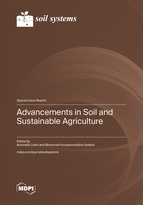Advancements in Soil and Sustainable Agriculture
A special issue of Soil Systems (ISSN 2571-8789).
Deadline for manuscript submissions: closed (30 September 2023) | Viewed by 28351
Special Issue Editors
Interests: sustainable agronomic management; soil quality; alternative crops; water stress; salinity stress; agronomy; herbaceous crops; quinoa; amaranth
Special Issues, Collections and Topics in MDPI journals
2. Interdepartmental Research Centre on the “Earth Critical Zone”, University of Naples Federico II, 80055 Portici, Italy
Interests: irrigation agronomy; alternative crops; legume breeding; protein crops; proximal sensing; abiotic stresses; water management in agriculture
Special Issues, Collections and Topics in MDPI journals
Special Issue Information
Dear Colleagues,
The need to reduce hunger in the world and to safeguard terrestrial ecosystems are the objectives of sustainable development; for this reason, innovations applied to cropping systems towards the sustainable intensification of production are very important. Globally, the decline in crop productivity is mainly due to climate change, a loss of soil fertility and a reduction in biodiversity. These findings, largely aggravated by population growth and the limited availability of arable land, require rational interventions to allow farmers to produce more efficiently.
Sustainable agriculture represents the virtuous innovation of the use and management of systemic agronomic technologies aimed, in particular, at reducing the environmental impact by emitting less CO2 emissions and reducing the need for fertilizers, pesticides, and herbicides, thus better protecting biodiversity, water, and soil using practices that build healthy soil and reduce erosion. It is also an agricultural approach that considers the economic aspects and social issues for the well-being and health of humanity on a global scale.
This Special Issue, entitled “Advancements in Soil and Sustainable Agriculture”, focuses on new and innovative approaches to making modern agriculture more soil-friendly, as well as on strategies for enhancing soil productivity.
Dr. Antonella Lavini
Dr. Mohamed Houssemeddine Sellami
Guest Editors
Manuscript Submission Information
Manuscripts should be submitted online at www.mdpi.com by registering and logging in to this website. Once you are registered, click here to go to the submission form. Manuscripts can be submitted until the deadline. All submissions that pass pre-check are peer-reviewed. Accepted papers will be published continuously in the journal (as soon as accepted) and will be listed together on the special issue website. Research articles, review articles as well as short communications are invited. For planned papers, a title and short abstract (about 100 words) can be sent to the Editorial Office for announcement on this website.
Submitted manuscripts should not have been published previously, nor be under consideration for publication elsewhere (except conference proceedings papers). All manuscripts are thoroughly refereed through a single-blind peer-review process. A guide for authors and other relevant information for submission of manuscripts is available on the Instructions for Authors page. Soil Systems is an international peer-reviewed open access quarterly journal published by MDPI.
Please visit the Instructions for Authors page before submitting a manuscript. The Article Processing Charge (APC) for publication in this open access journal is 1800 CHF (Swiss Francs). Submitted papers should be well formatted and use good English. Authors may use MDPI's English editing service prior to publication or during author revisions.
Keywords
- sustainable agriculture
- soil quality
- best agronomic practices
- soil physical properties
- soil management
- conservation agriculture
- precision agriculture
- cover crop and rotation
- water management
- nutrient management







